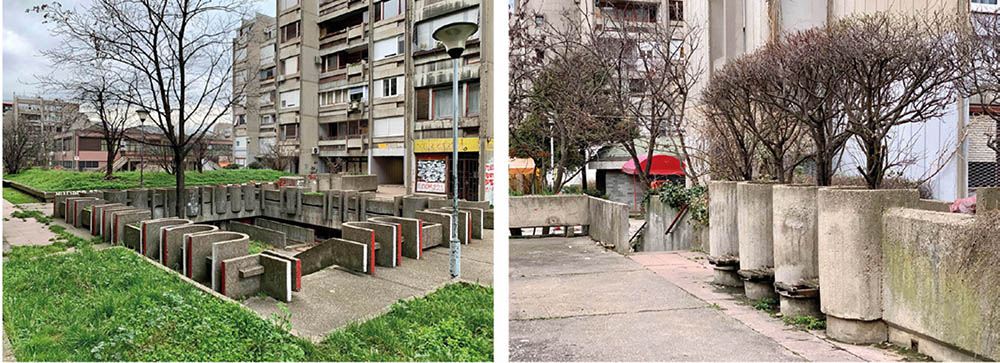Learning Connectedness and Belonging from Modern Movement – Case Study New Belgrade
Downloads
DOI:
https://doi.org/10.52200/docomomo.73.08Keywords:
times of pandemic, shared space, solitude, solidarity, social connectedness, modern interiorsAbstract
The boundaries between the private, shared, and public spheres are challenged in completely new ways in times of pandemics, and we need new strategies to redefine them. During pandemics, prevailing requests for physical distancing in the urban space eliminated the programs from everyday lives that all have included social interaction, exchange, and connectedness. So, the request for physical distance caused actual social distance, which further brought new problems of solitude and isolation to the individual in the urban environment. How can architecture and design help to provide physical distance while maintaining social closeness, empathy, and solidarity in cities?
Modern Movement heritage, especially in the countries that were under socialist political regimes, teaches us that shared spaces, collective spaces as part of public spaces, are places in which community is being formed and strengthened, where new forms of affiliation and belonging arise. The socialist paradigm emphasizes the importance of open public spaces within the residential zone as places for maintaining physical activity and health, as well as social interaction. By examining the modernist development of New Belgrade through a comparative analysis of two case studies focusing on the same area—specifically, the blocks known as Blok 22—we can reinvigorate the concept of the connection between the interior and shared spaces.
The specific values of open spaces within the residential modernist block have proven to be particularly important during times of crisis, such as the COVID-19 pandemic, especially regarding the degree of connectedness or separation between private and public spaces. During the pandemic, a student workshop was organized, resulting in projects that offered new architectural scenarios and models for using shared spaces in a residential block. These models allowed for the preservation of physical distance among individuals while enabling social interactions and even the emergence of new programs as an extension of housing. The workshop highlighted the importance of this concept not only during crises but also in contemporary living conditions in large cities, which struggle with issues of alienation and loneliness.
How to Cite
Published
Issue
Section
License
Copyright (c) 2025 Milena Kordić, Ana Zorić, Dejan Todorović, Rade Mrlješ

This work is licensed under a Creative Commons Attribution 4.0 International License.
Plaudit
References
BENJAMIN, W. (2002). The Arcades Project, Cambridge, Massachusetts, Harvard University Press.
BLAGOJEVIĆ, Lj. (2007). Modernism in Serbia: The elusive margins of Belgrade architecture 1919-1941. Cambridge, Massachusetts, The Massachusetts Institute of Technology Press and Harvard University Graduate School of Design.
BLAGOJEVIĆ, Lj. (2007). Novi Beograd – osporeni modernizam, Beograd: Zavod za udžbenike, Arhitektonski fakultet Univerziteta u Beogradu, Zavod za zaštitu spomenika kulture grada Beograd.
BRANKOV, B., & Manić, B. (2021). [Common Areas as Threatened Segment of Architectural Residential Heritage from the Second Half of the 20th Century, in: Architectural Heritage and Urban Planning, ed. Mrlješ, R., Belgrade: Cultural Heritage Preservation Institute of Belgrade: 94-105].
VESKOVIĆ, I. Jovanović, J. (2018).Izgradnjablokova 21, 22, 23 centralne zone Novog Beograda i njihov značaj u okviru kulturnog nasleđa Beograda [?], Nasleđe XIX, (Beograd): 35-51. DOI: https://doi.org/10.5937/nasledje1819035V
ĐJOKOVIĆ, M. (1972).Izgradnja stambenih objekata u bloku 22, Novi Beograd [?], u: Stan i stanovanje, ed. Bajlon, M. i Marković, A. Beograd: Časopis „IZGRADNJA“, Savez građevinskih inženjera i tehničara SR Srbije, Savez društava arhitekata Srbije, Savet za građevinarstvo Republičke privredne komore SR Srbije: 251-261.
ĐORĐEVIĆ, A. (1960). Urbanističko rešenje centralnog dela Novog Beograda [?], Arhitektura Urabanizam br. 2 (Beograd): 3-12.
HIRT, S. (2012). Iron Curtains: Gates, Suburbs and Privatization of Space in the Post-socialist City, Chichester, Oxford, Malden: John Wiley & Sons. DOI: https://doi.org/10.1002/9781118295922
JANKOVIĆ, B., & Karadžić, B. (1972).Izgradnja blokova 22 i 23 u Novom Beogradu [?], in: Stan i stanovanje, ur. BAJLON, M., & Marković, A. Beograd: Časopis „IZGRADNJA“, Savez građevinskih inženjera i tehničara SR Srbije, Savez društava arhitekata Srbije, Savet za građevinarstvo Republičke privredne komore SR Srbije: 134-147.
KULIĆ, V. (2013). National, supranational, international: New Belgrade and the symbolic construction of a socialist capital. The Journal of Nationalism and Ethnicity, 41(1), 35–63. DOI: https://doi.org/10.1080/00905992.2012.749224
KULIĆ, V. (2009). ‘East? West? Or Both?’ Foreign perceptions of architecture in Socialist Yugoslavia. The Journal of Architecture, 14(1), 129–147. DOI: https://doi.org/10.1080/13602360802705106
MAKSIMOVIĆ, B. (1969). Funkcionalne vrednosti slobodnih prostora u blizini stana [?] ,Arhitektura Urbanizam, 56-57, (Beograd): 96.
MILOVANOVIĆ, A., Kostić, M., Zorić, A., Đorđević, A., Pešić, M., Bugarski, J., Todorović, D., Sokolović, N., & Josifovski, A. (2020). Transferring COVID-19 Challenges into Learning Potentials: Online Workshops in Architectural Education, Sustainability 2020, 12, http://dx.doi.org/10.3390/su12177024 DOI: https://doi.org/10.3390/su12177024
MIŠKOVIĆ, J. (1969). Detaljan urbanistički plan blokova 22 i 23 u Novom Beogradu [?], Urbanizam Beograda br. 2, (Beograd): 8-10.
MRLЈEŠ, R. (2022). Arhitektura internacionalnog modernizma u kontekstu repozicioniranja socijalističke Jugoslavije na međunarodnoj sceni, Godišnjak za društvenu istoriju, XXIX sveska 2 [?], (Beograd): 29-47.
PROKOPLJEVIĆ, J. (2015). Do not throw concrete blocks! Social and Public Housing in New Belgrade and their Representations in Popular Culture. Fusion Journal, no. 6, http://fusion-journal.com/issue/006-fusion-the-rise-and-fall-of-social-housing-future-directions/do-not-throw-concrete-blocks-social-and-public-housing-in-new-belgrade-and-their-representations-in-popular-culture/
VAIS, D. (2023). THE IDEAL MODEL OF SOCIALIST MODERNISM Gheorgheni Housing Estate in Cluj. Do.Co Mo. Mo. Journal, 68(1), 36–44. DOI: https://doi.org/10.52200/docomomo.68.04
Izazovi Covid 19: Arhitektura pandemije, (2020) Publikacija rezultata online studenstske radionikce, Univerzitet u Beogradu – Arhitektonski fakultet





